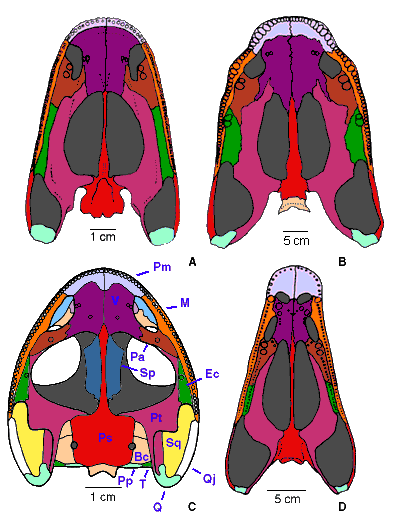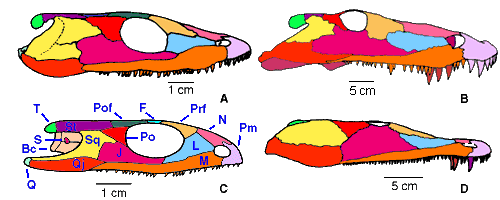,== Zatrachydidae
,==10|
| `== Dissorophoidea
,===8|
| | ,== Archegosauridae
,===7| `===9|
| | `== Eryopidae
| |
,===5| `============ Iberospondylus
| |
| | ,============ Cochleosauridae
,===4| `==6|
| | `============ Edopidae
,===3| |
| | `====================== Capetus
,===2| |
| | `=========================== Dendrerpeton
| |
======1| `================================ Balanerpeton
|
| ,================================ Dvinosauria
`==11|
| ,=========================== Rhinesuchidae
`==12|
| ,====================== Capitosauria
`==13|
| ,================= Trematosauridae
`==14|
| ,============ Metoposauroidea
`==15|
| ,======= Rhytidosteidae
`==16|
`======= Brachyopoidea
Consensus phylogeny of temnospondyls, from Milner and Sequeira (1994, 1998), Yates and Warren (2000) and Steyer (2000), and Laurin and Soler-Gijón (2006).
The following apomorphies (sorted by node) can be placed on the tree:
- Temnospondyli Zittel, 1888: interpterygoid vacuities broad, rounded anteriorly; alary process of premaxilla present (Laurin and Soler-Gijón, 2006); presence of palatal tusks (Fig. 1); vertebrae of 'rachitomous' to 'stereospondylous' type; and ornamented scapular elements.
 Click on an image to view larger version & data in a new window
Click on an image to view larger version & data in a new window
Figure 1. Temnospondyl skulls in palatal view. A, Dendrerpeton acadianum. B, the eryopid Eryops megacephalus. C, the dissorophoid Tersomius texensis. D, the archegosaurid Melosaurus vetustus. Redrawn from A, Holmes, Carroll and Reisz (1998); B, from Sawin (1941); C, from Carroll (1964); and D, from Konzhukova (1955). Abbreviations: Bc, braincase; Ec, ectopterygoid; M, maxilla; Pa, palatine; Pm, premaxilla; Pp, postparietal; Pt, pterygoid; Q, quadrate; Qj, quadratojugal; Sp, sphenoid; Sq, squamosal; T, tabular. Drawings copyright © 2000 Jean-Sébastien Steyer and Michel Laurin.
- Euskelia Yates and Warren, 2000: grooves for lateral line organ absent in adults; anterior palatal fossa absent (Laurin and Soler-Gijón, 2006).
- Unnamed clade including Dendrerpeton, Capetus, and eryopoids: jugal extends anterior to orbit (Laurin and Soler-Gijón, 2006).
- Unnamed clade including Capetus, and eryopoids: vomer excluded from rim of interpterygoid vacuity (Laurin and Soler-Gijón, 2006).
- Unnamed clade including edopoids, and eryopoids: septomaxilla possesses sculptured dermal flange (Laurin and Soler-Gijón, 2006).
- Edopoidea Romer, 1945 (as Edopsoidea): marginally elongate premaxilla (Milner and Sequeira, 1998); lacrimal excluded from orbit; premaxillay long; alary process of premaxilla absent; supratemporal narrow; interpeterygoid vacuity moderately broad, pointed anteriorly (Laurin and Soler-Gijón, 2006).
- Unnamed clade including Iberospondylus and eryopoids: occipital condyle bilobed, formed mostly by exoccipital; intertemporal absent (Laurin and Soler-Gijón, 2006).
- Unnamed clade including eryopoids and dissorophoids: vomer forms anterior margin of interpterygoid vacuity (Laurin and Soler-Gijón, 2006).
 Click on an image to view larger version & data in a new window
Click on an image to view larger version & data in a new window
Figure 2. Temnospondyl skulls in lateral view. A, Dendrerpeton acadianum. B, the eryopid Eryops megacephalus. C, the dissorophoid Tersomius texensis. D, the archegosaurid Melosaurus vetustus. Redrawn from A, Holmes, Carroll and Reisz (1998); B, from Sawin (1941); C, from Carroll (1964); and D, from Konzhukova (1955). Abbreviations: Bc, braincase; F, frontal; J, jugal; L, lacrimal; M, maxilla; N, nasal; Pm, premaxilla; Po, postorbital; Pof, postfrontal; Prf, prefrontal; Q, quadrate; Qj, quadratojugal; S, stapes; Sq, squamosal; St, supratemporal; T, tabular. Drawings copyright © 2000 Jean-Sébastien Steyer and Michel Laurin.
- Eryopoidea Cope, 1882 (as Eryopsoidea): relatively rounded choana (Steyer, 2000), and possibly, a vertical iliac blade (Yates and Warren, 2000).
- Dissorophoidea Bolt, 1969: exposure of the dorso-lateral margin of the palatine in the orbital margin; narial, prefrontal and supratympanic flanges; both large orbits and pineal foramen; and long and slender limb elements (when preserved) (Dilkes, 1990; Yates and Warren, 2000; Steyer, 2000).
- Limnarchia Yates and Warren, 2000: paraquadrate foramen on the occipital face of the quadratojugual; perforated anterior palatal fossa (Fig. 1D); ectopterygoid toothrow (Fig. 1D); pterygoid with a conical recess dorsal of the pterygoid-parasphenoid articulation; maxilla-vomer suture (Fig. 1D); loss of denticles on the vomers; discrete postglenoid area on the mandible; and relatively elongate interclavicle.
- Stereospondyli Frass, 1889: palatine ramus of the pterygoid posteriorly retracted (Fig. 1D); pterygoid with a flat, broad internal process articulating with most of the lateral edge of the parasphenoid plate (Fig. 1D); and ornamentation of the ventral surface of the pterygoid (Yates and Warren, 2000).
- Unnamed taxon including Capitosauria and Trematosauridae: double occipital condyle without contribution from the basioccipital; denticle field lost from all three coronoids; toothrow on posterior coronoid (Yates and Warren, 2000).
- Trematosauria Yates and Warren, 2000: loss of stapedial foramen (Yates and Warren, 2000).
- Unnamed taxon including Metoposauroidea and Rhytidosteidae: otic notch reduced to a wide, shallow embayment; open notch present instead of a supraglenoid foramen (Yates and Warren, 2000).
- Unnamed taxon including Rhytidosteidae and Brachyopoidea: lacrimal absent; absence of tooth rows or teeth on any coronoids (Yates and Warren, 2000).




 Go to quick links
Go to quick search
Go to navigation for this section of the ToL site
Go to detailed links for the ToL site
Go to quick links
Go to quick search
Go to navigation for this section of the ToL site
Go to detailed links for the ToL site